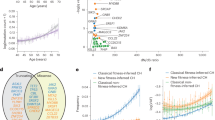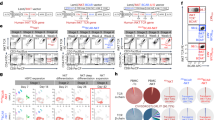Abstract
Dihydrofolate reductase (DHFR) deficient chinese hamster ovary (CHO) cells were cotransfected with a plasmid containing the human antithrombin III (AT III) cDNA preceded by the SV40 early promoter, and plasmids containing the mouse DHFR cDNA under the control of either the mouse mammary tumor virus long terminal repeat (MMTV–LTR) promoter or without any known eukaryotic promoter. Cell clones were selected that expressed the DHFR–gene despite the absence of a promoter in the latter case. The AT III cDNA was efficiently expressed in both cell types. After amplification with methotrexate (MTX), various cell lines secreted up to 22 μg AT III/106 cells/24 h. AT III was isolated from the medium of cultured cells and shown to be indistinguishable from human plasma derived AT III by immunological criteria and biological activity.
This is a preview of subscription content, access via your institution
Access options
Subscribe to this journal
Receive 12 print issues and online access
$209.00 per year
only $17.42 per issue
Buy this article
- Purchase on Springer Link
- Instant access to full article PDF
Prices may be subject to local taxes which are calculated during checkout
Similar content being viewed by others
References
Rosenberg, R.D. 1983. Antithrombin III, biochemistry, function, assay and clinical significance. Ann. Univ. Sarav. Med. 3: 13–14.
Damus, P.S., Hicks, M., and Rosenberg, R.D. 1973. Anticoagulant action of heparin. Nature 246: 355–357.
Abildgaard, U., Fagerhol, M.K. and Egeberg, D. 1970. Comparison of progressive antithrombin activity and the concentration of three thrombin inhibitors in plasma. Scand. J. Clin. Invest. 26: 349–354.
Thaler, E., Balzer, E., Kopsa, H., and Pinggera, W.F. 1978. Acquired antithrombin III deficiency in patients with glomerular proteinuria. Haemostasis 7: 257–272.
Fagerhol, M.K. and Abildgaard, U. 1970. Immunological studies on human antithrombin III. Scand. J. Haematol. 7: 10–17.
Egeberg, O. 1965. Inherited antithrombin deficiency causing thrombophilia. Thromb. Diath. Haemorrh. 13: 516–541.
Sas, G., Blasko, G., Banhegyi, D., Jako, J., and Palos, L.A. 1974. Abnormal antithrombin III (antithrombin III Budapest) as a cause of familiar thrombophilia. Thromb. Diath. Haemorrh. 32: 105–115.
Sorensen, P.J., Dyerberg, J., Stoffersen, E., and Jensen, M.K. 1980. Familiar functional antithrombin III deficiency. Scand. J. Haematol. 24: 105–109.
Koide, T., Odani, S., Takahashi, K., Ono, T., and Sakuragawa, N. 1984. Antithrombin III Toyama: Replacement of arginine-47 by cysteine in hereditary abnormal antithrombin III that lacks heparin-binding ability. Proc. Natl. Acad. Sci. USA 81: 289–293.
Nordeman, B., Nystroem, C., and Björk, I. 1977. The size and shape of human and bovine antithrombin III. Eur. J. Biochem. 78: 195–203.
Franzen, L.-E. and Svensson, S. 1980. Structural studies on the carbohydrate portion of human antithrombin III. J. Biol. Chem. 255: 5090–5093.
Bock, S.C., Wion, K.L., Vehar, G.A. and Lawn, R.M. 1982. Cloning and expression of the cDNA for human antithrombin III. Nucl. Acids Res. 10: 8113–8125.
Prochownik, E.V., Markham, A.F. and Orkin, S.H. 1983. Isolation of a cDNA clone for human antithrombin III. J. Biol. Chem. 258: 8389–8394.
Chandra, T., Stackhouse, R., Kidd, V.J. and Woo, S.L.C. 1983. Isolation and sequence characterization of a cDNA clone of human antithrombin III. Proc. Natl. Acad. Sci. USA 80: 1845–1848.
Colau, B., Cravador, A., Loriau, R., van Elsen, A., Hoylaerts, M., Jacobs, P., Herzog, A., and Bollen, A. 1985. Molecular cloning, sequencing and expression of a cDNA coding for human antithrombin III. Protides of the Biol. Fluids 33: 157–160.
Prochownik, E.V., Bock, S.C. and Orkin, S.H. 1985. Intron structure of the human antithrombin III gene differs from that of other members of the serine protease inhibitor superfamily. J. Biol. Chem. 260: 9608–9612.
Prochownik, E.V. 1985. Relationship between an enhancer element in the human antithrombin III gene and an immunoglobulin light-chain gene enhancer. Nature 316: 845–848.
Prochownik, E.V. and Orkin, S.H. 1984. In vivo transcription of a human antithrombin III “minigene”. J. Biol. Chem. 259: 15386–15392.
Kaufman, R.J. and Sharp, P.A. 1982. Amplification and expression of sequences cotransfected with a modular dihydrofolate reductase cDNA gene. J. Mol. Biol. 159: 601–621.
Ringold, G., Dieckmann, B. and Lee, F. 1981. Co-expression and amplification of dihydrofolate reductase cDNA and Escherichia coli XGPRT gene in Chinese hamster ovary cells. J. Mol. Appl. Genet. 1: 165–175.
Urlaub, G. and Chasin, L.A. 1980. Isolation of Chinese hamster cell mutants deficient in dihydrofolate reductase activity. Proc. Natl. Acad. Sci. USA 77: 4216–4220.
Ouchterlony, O. 1958. Progr. Allergy 5: 1–78.
Kaufman, R.J., Wasley, L.C., Spiliotes, A.J., Gossels, S.D., Latt, S.A., Larsen, G.R. and Kay, R.M. 1985. Coamplification and coexpression of human tissue-type plasminogen activator and murine dihydrofolate reductase sequences in Chinese hamster ovary cells. Mol. Cell. Biol. 5: 1750–1759.
Kaufman, R.J., Wasley, L.C., Furie, B.C. and Shoemaker, C.B. 1986. Expression, purification and characterization of recombinant γ-carboxylated Factor IX synthesized in Chinese Hamster Ovary Cells. J. Biol. Chem. 261: 9622–9628.
Mory, Y., Ben-Barak, J., Segev, D., Cohen, B., Novick, D., Fischer, D.G., Rubenstein, M., Kargman, S., Zilberstein, A., Vigeron, M. and Revel, M. 1986. Effective constitutive production of human IFN-γ in Chinese hamster ovary cells. DNA 5: 181–193.
Michel, M.-L., Sobczak, E., Malpièce, Y., Tiollais, P., and Streeck, R.E. 1985. Expression of amplified Hepatitis B Virus surface antigen genes in Chinese hamster ovary cells. Bio/Technology 3: 561–566.
Lee, F., Mulligan, R., Berg, P. and Ringold, G. 1981. Glucocorticoids regulate expression of dihydrofolate reductase cDNA in mouse mammary tumor virus chimaeric plasmids. Nature 294: 228–232.
Langner, K.D., Weyer, U. and Doerfler, W. 1986. Trans effect of the E1 region of adenoviruses on the expression of a prokaryotic gene in mammalian cells: Resistance to 5′-CCGG-3′ methylation. Proc. Natl. Acad. Sci. USA 83: 1598–1602.
Bröker, M., Ragg, H. and Karges, H.E. 1987. Expression of human antithrombin III in Saccharomyces cerevisiae and Schizosaccharomyces pombe. Biochem. Biophys. Acta 908: 203–213.
Bröker, M. and Amann, E. 1986. pUC12-STOP: An expression vector with portable translation stop signals. Appl. Microbiol. Biotechnol. 23: 294–296.
Bourachot, B., Jouanneuau, J., Giri, I., Katinka, M., Cereghini, S., and Yaniv, M. 1982. Both early and late control sequences of SV40 and polyoma promote transcription of Escherichia coli gpt gene in transfect-ed cells. EMBO Journal 1: 895–900.
Graham, F.L. and van der Eb, A. 1973. A new technique for the assay of infectivity of human adenovirus-5 DNA. Virology 52: 456–467.
Wurm, F.M., Gwinn, K.A. and Kingston, R.E. 1986. Inducible overproduction of the mouse c-myc protein in mammalian cells. Proc. Natl. Acad. Sci. USA 83: 5414–5418.
Maniatis, T., Fritsch, E.F. and Sambrook, J. 1982. Molecular Cloning—A Laboratory Manual. Cold Spring Harbor, New York.
Miller-Andersson, M., Borg, J. and Andersson, L.O. 1974. Purification of antithrombin III by affinity chromatography. Thromb. Res. 5: 439–452.
Hensen, A. and Loeliger, E.A. 1963. Antithrombin III assay. Thromb. Diatl. Haemorrh. 9 (Supp. 1): 18–29.
Kirkwood, T.B.L., Barrowcliffe, T.W. and Thomas, D.P. 1980. An international collaborative study establishing a reference preparation for antithrombin III. Thromb. Haemost. 43: 10–15.
Schrader, J., Züchner, C., Köstering, H. and Scheler, F. 1986. Chromogenic substrates for the determination of antithrombin III. Arztl. Lab. 32: 111–114.
Laemmli, U.K. 1970. Cleavage of structural proteins during the assembly of the head of bacteriophage T4. Nature 227: 680–685.
Burnette, W.N. 1981. “Western blotting”: electrophoretic transfer of proteins from sodium dodecyl sulfate-polyacrylamide gels to unmodified nitrocellulose and radiographic detection with antibody and radio-iodinated protein A. Analyt. Biochem. 112: 195–203.
Author information
Authors and Affiliations
Rights and permissions
About this article
Cite this article
Zettlmeissl, G., Ragg, H. & Karges, H. Expression of Biologically Active Human Antithrombin III in Chinese Hamster Ovary Cells. Nat Biotechnol 5, 720–725 (1987). https://doi.org/10.1038/nbt0787-720
Received:
Accepted:
Issue Date:
DOI: https://doi.org/10.1038/nbt0787-720



